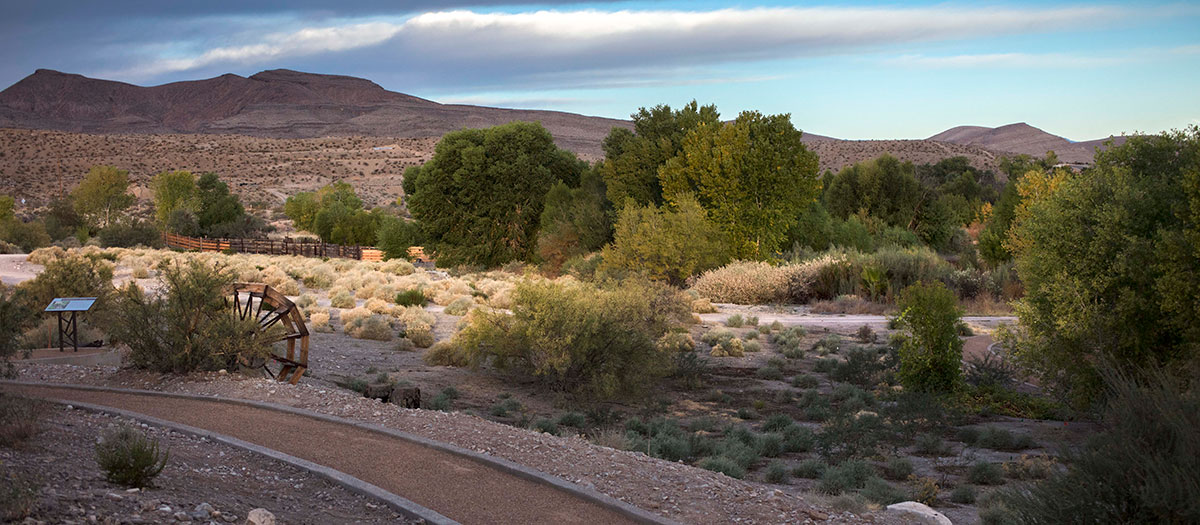Located near the town of Moapa, the Warm Springs Natural Area contains more than two dozen springs, which form the headwaters of the Muddy River.
Formerly known as the Warm Springs Ranch, the 1,220-acre property provides habitat for several sensitive species. For many years prior to the Southern Nevada Water Authority's involvement, the U.S. Fish & Wildlife Service considered this property a top priority in Southern Nevada for acquisition and protection.
Why the Warm Springs Natural Area is important
In 2007, the Water Authority purchased the property to protect the headwaters of the Muddy River and the habitat of the endangered Moapa dace with funding from the Southern Nevada Public Land Management Act. The terms of the act require a commitment to manage the property as a natural area.
A Stewardship Plan was developed for the Warm Springs Natural Area in coordination with the U.S. Fish and Wildlife Service, The Nature Conservancy, Nevada Department of Wildlife, the signatories of the 2006 Memorandum of Agreement, and other stakeholders. The Warm Springs Natural Area opened to the public in December 2017.
Primary reasons for acquisition of the Warm Springs Natural Area:
- Manage our water resources in the Muddy River and Coyote Spring Valley
- Protect the habitat of the endangered Moapa dace
- Protect the headwaters of the Muddy River where we own and lease water rights
- Advance our goal of fostering responsible environmental stewardship
Gone fishing, sort of
In addition to being the home of the endangered Moapa dace fish, the Warm Springs Natural Area is also one of the best kept secrets in Southern Nevada.
Sensitive species
The Warm Springs Natural Area is home to 28 sensitive species, more than 200 species of birds, and a wide variety of other species.
- Most of the entire world's population of Moapa dace reside in the Moapa Valley National Wildlife Refuge and the Warm Springs Natural Area. The Moapa dace is protected by the Endangered Species Act, and the U.S. Fish and Wildlife Service (USFWS) considers the recovery of the Moapa dace to be essential in this region.
- The endangered Southwestern willow flycatcher, yellow-billed cuckoo, threatened desert tortoise and several species listed as critically imperiled by the State of Nevada can be found at the Warm Springs Natural Area.
- The Warm Springs Natural Area is home to the largest breeding population of vermilion flycatchers in Nevada.
Species managed under the Warm Springs Natural Area Stewardship Plan:
- Moapa dace (Moapa coriacea)
- Virgin River chub (Gila seminuda)
- Moapa speckled dace (Rhinichthys osculus moapae)
- Moapa White River springfish (Crenicthis baileyi moapae)
- Southwestern willow flycatcher (Empidonax traillii extimus)
- Yellow-billed cuckoo (Coccyzus americanus occidentalis)
- Yuma Ridgway’s rail (Rallus obsoletus yumanensis)
- Phainopepla (Phainopepla nitens)
- Vermilion flycatcher (Pyrocephalus rubinus)
- Summer tanager (Piranga rubra)
- Townsend’s big-eared bat (Corynorhinus townsendii)
- Spotted bat (Euderma maculatum)
- Western red bat (Lasiurus blossevollii)
- Western yellow bat (Lasiurus xanthinus)
- California leaf-nosed bat (Macrotus californicus)
- Fringed myotis (Myotis thysanodes)
- Big free-tailed bat (Nyctinomops macrotis)
- Western naucorid (Ambrysus mormon)
- Moapa naucorid (Limnocoris moapensis)
- Warm Springs crawling riffle beetle (Haliplus eremicus)
- MacNeill sooty-winged skipper (Hesperopsis gracielae)
- Moapa riffle beetle (Microcylloepus moapus)
- Pahranagat naucorid (Pelocoris biimpressus shoshone)
- Moapa pebblesnail (Pyrgulopis avernalis)
- Moapa Valley pyrg (Pyrgulopis carinifera)
- Moapa Warm Springs riffle beetle (Stenelmis moapa)
- Moapa skater (Rhagovelia becki)
- Desert tortoise (Gopherus agassizii)
Visit the Warm Springs Natural Area
Open to the public from Labor Day through Memorial Day, the Warm Springs Natural Area offers a 2/3-mile trail, informational kiosks, and a breathtaking overlook.
